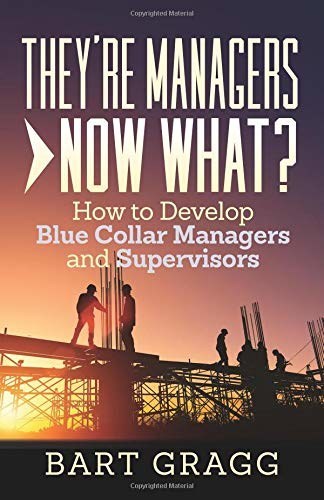CONCORD, Calif., Feb. 26, 2019 /PRNewswire/ — If you are training blue collar workers to become managers, it pays to understand learning styles.
“Remember when moving from labor into management, people change from working primarily with tools and objects to working primarily with people and data,” says Bart Gragg, founder of Blue Collar University. “This requires broadening neural pathways to the previously lesser used areas of the brain.”

Gragg is author of the book, They’re Managers – Now What? How to Develop Blue Collar Managers and Supervisors(2018, www.indiebooksintl.com).
To simplify training matters and make the learning style terms more user friendly, Gragg consulted with a retired learning specialist, Beth Mermann. From those discussions emerged a list of terms to describe the way blue collar workers learn best. Gragg rejected the simple notions of three learning styles: visual, auditory and kinesthetic.
“Bear in mind that people learn in a combination of two or more ways,” says Gragg. “Note that many of the ways people learn can be categorized as visual learners, but there are more ways than one to learn visually.”
According to Gragg, here are the eight different learning styles blue collar workers who become managers use to make the jump:
Walkers pace or walk while thinking and/or talking. The movement helps them process what they are learning or thinking about.
Talkers have to talk it out – that is, they process by going over everything verbally, often stopping and asking questions, some of which may be rhetorical. then answering it themselves and move on to the next potential sequence of events. Sometimes they walk and talk.
Writers write things down which helps to cement things in their minds. This is actually one of the more universal ways of getting people to learn and to process information. It’s why we use spiral notebooks with everyone.
Drawers like images, shapes, drawings, blueprints, flow charts and useful videos that show the process, like whiteboard videos. When they try to explain something, you might see them drawing it out on paper, on the whiteboard, with a pencil on a piece of wood, a stick in the dirt and so forth. And you might see them watching a video online to see how some process works.
Thinkers mentally visualize the process before attempting it.
Listeners learn by hearing themselves talk it out or others telling them about it.
Doers learn by attempting the task at hand, especially if it involves something physical.
Sensors learn by feeling their way through a situation with intuition. They do this in combination with visualizing, talking, asking questions, and other processes, but the core attempts are to feel their way through a situation as opposed to try to know the answer before moving forward.
“There are a great many ways to make training more effective,” says Gragg. “When trying to get a group of managers to edit and revise Word documents, I created a screen capture video including narration of the process and posted it on the company’s YouTube channel. In another instance we created a whiteboard video training for hazard communications and made it specific to the client’s needs. Both of those methods combine several of the learning types referred to above.”
About Indie Books International
Indie Books International (www.indiebooksintl.com) was founded in 2014 in Oceanside, California by two best-selling business authors. Since then the company has released more than 100 titles. Similar to indie film companies and indie music labels, the mission of Indie Books International is to serve as an independent publishing alternative for business thought leaders.
Contact
Henry DeVries
[email protected]
619-540-3031
SOURCE Indie Books International
